Menus
- Golden cucumbers
- Ducati Multistrada in 3rd place
- Original article from MOTORRAD 22/2007
- BMW C1 the clear winner
- 20th place: BMW K1
- 19th place: Suzuki RF 900 R
- 18th place: Honda VTR 1000 SP-2
- 17th place: Kawasaki KLE 500
- 16th place: Moto Guzzi Centauro
- 15th place: Honda FMX 650
- 14th place: Buell Ulysses XB12X
- 13th place: MZ Scorpio
- 12th place: Sachs Roadster 800
- 11th place: Yamaha BT 1100 Bulldog
- 10th place: Suzuki TL 1000
- 9th place: Aprilia RST 1000 Futura
- 8th place: Yamaha GTS 1000
- 7th place: Ducati Indiana
- 6th place: Bimota mantra
- 5th place: Munch Mammut
- 4th place: BMW F 650 Scarver
- 3rd place: Ducati Multistrada
- 2nd place: BMW R 1200 C Montauk
- 1st place: BMW C1
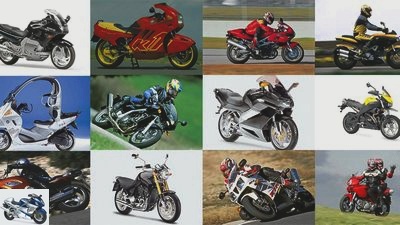
Photo: archive

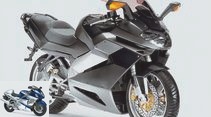

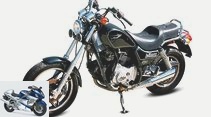
20th photos
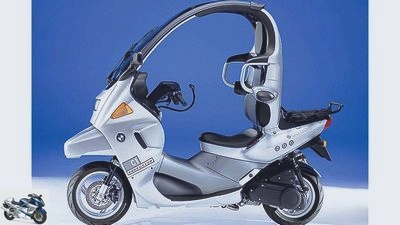
Manufacturer
1/20
1st place: BMW C1.
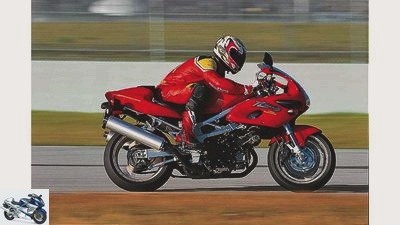
2/20
10th place: Suzuki TL 1000.
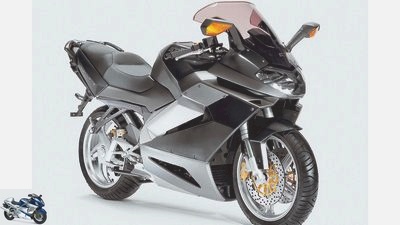
3/20
9th place: Aprilia RST 1000 Futura.
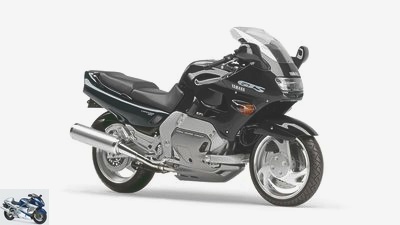
Manufacturer
4/20
8th place: Yamaha GTS 1000.

Manufacturer
5/20
7th place: Ducati Indiana.

6/20
6th place: Bimota mantra.
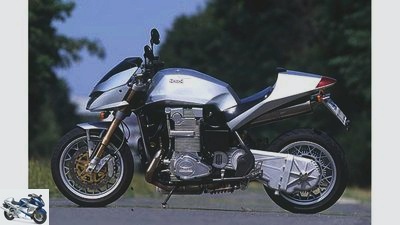
7/20
5th place: Munch Mammut 2000.
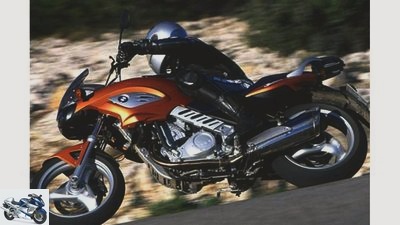
8/20
4th place: BMW F 650 Scarver.
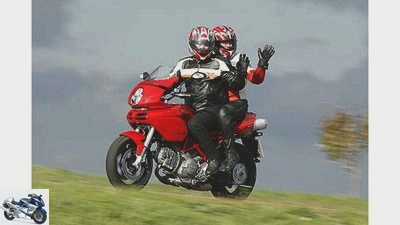
9/20
3rd place: Ducati Multistrada.
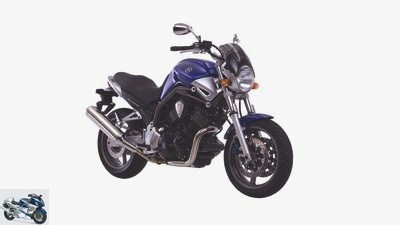
Manufacturer
10/20
11th place: Yamaha BT 1100 Bulldog.
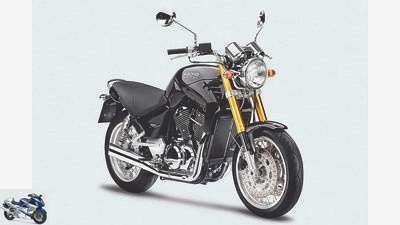
11/20
12th place: Sachs Roadster 800.

12/20
20th place: BMW K1.
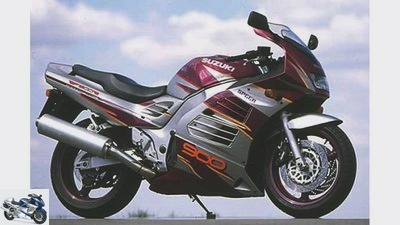
13/20
19th place: Suzuki RF 900 R.
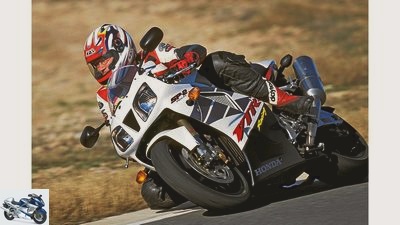
14/20
18th place: Honda VTR 1000 SP-2.
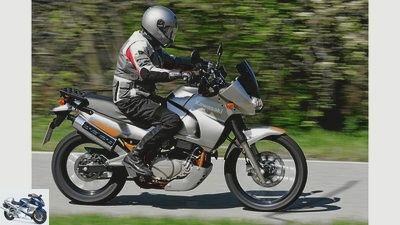
Bilski
15/20
17th place: Kawasaki KLE 500.
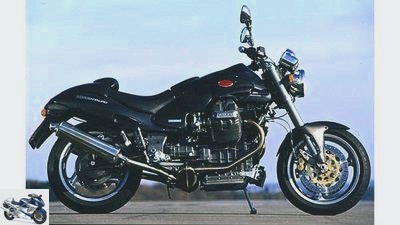
16/20
16th place: Moto Guzzi Centauro.
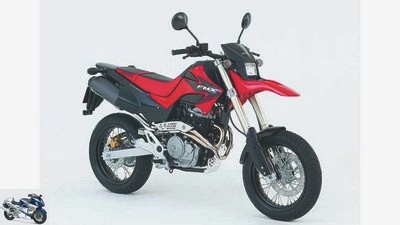
Manufacturer
17/20
15th place: Honda FMX 650.
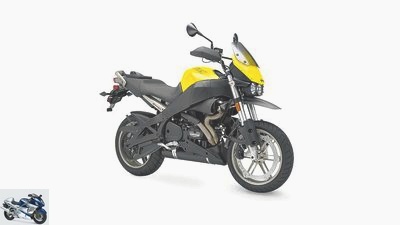
Manufacturer
18/20
14th place: Buell Ulysses XB12X.

19/20
13th place: MZ Scorpio.

Manufacturer
20/20
2nd place: BMW R 1200 C Montauk.
The 20 greatest motorcycle flops of modern times
Golden cucumbers
In 2007, MOTORRAD called for a major reader survey: they were looking for the biggest two-wheeler flop of modern times. With a little distance we are now paying tribute to the election result from that time.
In which models has the trend continued at that time? Are there models that have taken a different path and have become sought-after collector’s items? And which models are still being developed by manufacturers today? For example, if you look at the BMW C1 scooter, which took first place at the time, you cannot speak of a complete flop. Although BMW stopped production relatively early and sold the naming rights early on, there is still a fan scene that is enthusiastic about the somewhat idiosyncratic concept to this day. The current used market prices for the covered scooter also show that the C.1 has not yet completely disappeared from the scene.
Ducati Multistrada in 3rd place
Another positive example is the Ducati Multistrada. Even then, the travel enduro could not be called a complete flop, at least in its home country. Ducati stuck to the Multistrada and continued to develop it. Today the Multistrada is one of the most popular travel enduros on the market. So not all flops back then have disappeared into oblivion. You can find out below and in the picture gallery which two-wheelers were voted into the “Flop 20” by the readers at the time.
Original article from MOTORRAD 22/2007
You have voted, dear readers. And so the ten biggest two-wheel flops of modern times were determined from 22 suggestions. MOTORRAD has researched for you why these bikes were not favored by the public and what advantages they still offered. But read for yourself…
At the film festival, the worst flick is honored with the “Golden Raspberry” on the evening before the Academy Awards. So far, this has not happened in the motorcycle sector. At least officially. However, there are some models that seem to have been developed by the customer – they did not sell well. There can be many reasons for this. In most cases, however, it had something to do with courage.
Flop or not? Today, five years after the end of production, the C1 is already considered a cult.
Courage to try something new. For example, many ideas came from the Bavarian innovation forge that were perhaps ahead of their time. The covered scooter C1, for example, the fully clad and aerodynamically optimized K1 or even the F 650 CS Scarver: All of them bypassing the public’s taste.
Some bikes also flopped because the motorcycle did not match the manufacturer’s image. Ducati made the leap into the cruiser business with the Indiana and tried to cut a large piece of the Enduro pie with the Multistrada. Buell also wanted the latter with the Ulysses. It failed. Yamaha felt that courage in technical terms is sometimes not rewarded either. The elaborate Ackermann steering did not bring the GTS 1000 any noticeable advantages either when driving or compared to the competition.
In addition to smoothly functioning technology, the appearance is ultimately also decisive, because quite a few buyers are guided by their guts. If it tingles while looking at it, the machine can be so fat, have too little horsepower or turn around the corner worse than the competition. Then it’s love.
BMW C1 the clear winner
So here they are, the twenty biggest flops that you, dear readers, have chosen. It may come as a surprise that 41.6 percent of all entries were for the BMW C1. The R 1200 C Montauk was only able to unite 10.1 percent of the votes and nine percent went to the third-placed Ducati Multistrada.
Clear double victory for BMW – albeit in a negative ranking: The R 1200 C Montauk takes second place on the flop list.
There is probably a consensus among the motorcyclists about what they do not like, because up to tenth place (Suzuki TL 1000 with 1.3 percent), 93 percent of the votes had already been awarded. Although the manufacturers have drawn their conclusions from the failure, they should not lose the courage to break new ground in the future either. Because standing still is going backwards. And courage is often rewarded. Unusual ideas don’t have to go straight to the trash.
20th place: BMW K1
Very daring: BMW K1.
Bayern’s attempt to bring a super sports car to market went completely wrong. The angular shellfish has just sold 2,000 times in Germany.
BMW K1 in the MOTORRAD used market
More articles about the BMW K1
19th place: Suzuki RF 900 R
archive
Suzuki RF 900 R.
The design, which took some getting used to, and Suzuki’s idea of wanting to offer a “comfort athlete” made customers shiver. 2,912 pieces could be sold.
Suzuki RF 900 R in the MOTORRAD used market
More articles about the Suzuki RF 900 R
18th place: Honda VTR 1000 SP-2
markus-jahn.com
Honda VTR 1000 SP-2.
It was too sharp for sports touring riders, but against the racers from Bologna it was considered too blunt a weapon. From the SP-1 to the SP-2 only 9,000 units were sold.
Honda VTR 1000 SP-2 in the MOTORCYCLE used market
More articles about the Honda VTR 1000 SP-2
17th place: Kawasaki KLE 500
Bilski
Kawasaki KLE 500.
It was neither a travel machine nor an enduro. The range is too short, the motorcycle is too heavy, the engine is too slow. In twelve years of construction, it has just sold 10,000 times.
Kawasaki KLE 500 in the MOTORRAD used market
More articles about the Kawasaki KLE 500
16th place: Moto Guzzi Centauro
archive
Very fashionable: Moto Guzzi Centauro.
Fat tail, a crowbar as a handlebar – that’s how Guzzi shocked his clientele in the mid-90s with the fashionable Centauro. A fashion that was rejected.
More articles about the Moto Guzzi Centauro
15th place: Honda FMX 650
Manufacturer
Honda FMX 650.
The attempt to knit an inexpensive entry-level bike from simple components has failed. By the way: More than 38 hp should have been quiet…
Honda FMX 650 in the MOTORCYCLE used market
More articles about the Honda FMX 650
14th place: Buell Ulysses XB12X
Manufacturer
Buell Ulysses XB12X.
This is how the Americans interpret the topic of travel enduro. It is no wonder then that so far only a few globetrotters have fallen for the Ulysses that takes getting used to.
Buell Ulysses XB12X in the MOTORRAD used market
More articles on the Buel Ulysses XB12X
13th place: MZ Scorpio
archive
MZ Scorpio.
Whether tour, traveler, sport or replica, all scorpions could be seen. But a worn-out Japan single in a German chassis? A no-go!
More articles about the MZ Skorpion Tour
More articles about the MZ Skorpion Traveler
More articles about the MZ Skorpion Sport
12th place: Sachs Roadster 800
archive
Sachs Roadster 800.
It looked nice, the two-cylinder Sachs. But who wanted a middle-grader with a cardan who rode a Japan bike ten years earlier? Hardly anyone.
More articles about the Sachs Roadster 800
11th place: Yamaha BT 1100 Bulldog
Manufacturer
Yamaha BT 1100 Bulldog.
Lots of displacement, little power: many found the air-cooled V-twin-cylinder cardan all-rounder not only too weak, but also boring and far too expensive.
Yamaha BT 1100 Bulldog in the used MOTORCYCLE market
More articles about the Yamaha BT 1100 Bulldog
10th place: Suzuki TL 1000
archive
Half-baked: Suzuki TL 1000.
When is a flop a flop? Is it the registration numbers? In its prime, more TL 1000 than Ducati 916 were certainly sold. Is It The Wrong Concept? Ducati still builds magnificent sporty two-cylinder engines, Aprilia does it, KTM comes with the RC8, and even BMW spices up the boxer. And why? Because you can have a lot of driving fun on a sporty two-cylinder. Also on the TL 1000.
So it depends on how you define “flop”. According to the criteria mentioned above, the TL 1000 was definitely not a flop, but one of the most exciting, beautiful and exciting motorcycles to have come from Japan in the recent past. However, if a motorcycle is considered a flop because it is not fully developed, keyword rotary vane damper, missing steering damper, engine misfires, oil increase, then the TL 1000 could fall into this category.
Suzuki TL 1000 in the MOTORRAD used market
More articles about the Suzuki TL 1000
9th place: Aprilia RST 1000 Futura
archive
Canted: Aprilia RST 1000 Futura.
Your name said it all. But unfortunately only related to design. Many of those touring sports fans who were able to make friends with the very angular disguise outfit got puzzled due to the lack of technical features. Because a »future machine« without G-Kat and ABS – at least the German customers showed little interest. While the sports tourer was available for sale in Italy for another year, the Futura disappeared completely from German shop windows in 2002 after only two years of stage appearance
Aprilia RST 1000 Futura in the MOTORRAD used market
More articles about the Aprilia RST 1000 Futura
8th place: Yamaha GTS 1000
Manufacturer
Thigh-tapping: Yamaha GTS 1000.
It could have become the FJR 1300 of its time, thanks to its suitability for touring and the excellent ride comfort it offered. But these virtues were played smoothly against the wall by the stub axle steering. It’s just stupid that this did not bring any advantages over a much criticized telescopic fork.
At least none that customers and testers opened up. Disadvantages such as the uneven suspension on staccato bumps, the stubborn self-steering behavior of the flat contoured 130 mm front tire and a comparatively stiff steering, on the other hand, noticed immediately and renounced the self-tormenting pleasure of innovation for the sake of innovation.
Yamaha GTS 1000 in the MOTORCYCLE used market
More articles about the Yamaha GTS 1000
7th place: Ducati Indiana
Manufacturer
Inner values: Ducati Indiana.
A chopper from a sports motorcycle forge? That just had to go in the pants. Even if soft choppers were very popular in the 80s. The Indiana had a V2 engine, but the cylinders didn’t even spread the 45 degrees that promised easy-riding and was basically a real sports engine. To make matters worse, it was also part of a large enduro …
And above that, the real qualities of Indiana fell completely behind. Because the high seating position caused by the chassis turned out to be quite comfortable and ensured that there was no lean angle. The Ducati was also nimble and agile. And what many overlooked: The Desmodue was tailored to its intended use, offered great pulling power and an extremely wide speed range.
But it was like in real life: If it doesn’t spark at first glance, getting to know one another usually won’t work. And so the Indiana remained a tip for friends of the exotic.
More articles on Ducati Indiana
6th place: Bimota mantra
archive
Design accident: Bimota mantra.
It was the design: this bulbous monster of the tank that flows into the headlight, this lying two-in-four exhaust system and, to top it off, root wood as a literal dashboard. Who should warm to such a styling victim? She had to be a flop. It has always been a failure when famous designers from other industries created motorcycles. Think of Philippe Starck’s Aprilia Moto 6.5 or Pininfarina’s Morbidelli V8. So why should Sascha Latigue’s Bimota mantra work.
The mantra went quite well. Sounded furious and was very well-mannered. But Bimota stood for ultra-sporty racing replicas, a muscle bike was not in the minds of the fans. Especially since the Ducati engine only visually suggested power. Perhaps the mantra came 15 years early.
More articles on the Bimota mantra
5th place: Munch Mammut
Oh, you big egg: Munch Mammut 2000.
The key data of the motorcycle brute were enormous: 260 hp, 295 Newton meters, 176,000 marks – this is how the Munch Mammut 2000 project was presented to the world seven years ago. But of the originally planned 250 copies, only 15 were built and only eight of them were sold. It wasn’t just the price. The engine was almost impossible to drive.
Little happened around the bottom, followed by a performance effort with the force of an explosion that made even very experienced bikers sweat on their foreheads. In addition, the mammoth lived up to its name. It was unwieldy, heavy, had hardly any lean angle and an enormous seat height. But at least it is legendary.
More articles about the Munch Mammut
4th place: BMW F 650 Scarver
archive
Egg pot: BMW F 650 Scarver.
The plan was perfect: at the same time as the presentation of the Apple iPod in October 2001, BMW also wants to get a hold of the youngsters. Stylistically unmistakably inspired by the shimmering colored design of the trend computer, the Scarver should finally lure youngsters from the computer onto the bike. In addition to the unusual look, an audio system integrated into the dummy fuel tank spices up the F 650 GS, which serves as the basis. Technically, the 54 hp single is essentially differentiated by a toothed belt from the chain-driven GS.
But the boys – the target group were 20 to 30-year-olds – neither want Robbie Williams in the tank nor an Apple with a motor. Sales are sluggish, at the end of 2005 the Scarver – now available in 24 color variations – will be removed from the model range. Said boys are now sitting on KTM supermotos, Japanese super athletes – or still behind their laptops. Maybe one from Apple. pm
BMW F 650 Scarver in the MOTORRAD used market
More articles on the BMW F 650 Scarver
3rd place: Ducati Multistrada
archive
Not fish, not meat: Ducati Multistrada.
Ducati broke new ground in 2002 with the 1000 Multistrada in concept and design. Courageous and yet slightly off, sporty and yet with an upright, dignified seating position even for the pillion passenger. The fiery red Italian with the open-hearted tubular space frame breaks conventions to this day. A long-legged tourer, but not a classic travel enduro and certainly not a supermoto. The Multistrada was denied success, at least in this country. In their home country Italy, on the other hand, the »multi« is not considered a flop.
Then what bothers the Germans about the Duc? One explanation is certainly the design that takes getting used to. The upper part of the fairing and the instruments swivel to the right and left with the wide handlebar.
Right in the middle, between bulging curves, beads and edges: a Cyclops headlight of indefinable shape. It’s like the 999: an ugly face kills the best motorcycle. And at the stern, two mufflers in grenade launcher format stretch into the sky.
Anyone who pulls themselves up for a test drive despite the styling will get with the current 1100 – 1000 and 620 are no longer in the range – an inspiring air-cooled V2 engine under their buttocks: cultivated, powerful and extremely lively. Perhaps word of the Duc’s driving qualities did not get around either: its light-footed, almost wobbly nervous handling. The equipment with immobilizer, on-board computer and fully adjustable chassis can convince. The chassis works way too much on the tight side of life, however. The stucco upside-down fork responds badly, and like the hard spring strut, it only feels really good on picture-perfect asphalt. An outright lie of life for such a high-decker. Just like the lack of ABS option. It’s a shame, because with maintenance intervals of 10,000 and inspection costs that have been manageable since 2007, there could actually be more for this hybrid creature.
Ducati Multistrada in the MOTORRAD used market
More articles about the Ducati Multistrada 1000
More articles about the Ducati Multistrada 1100
More articles about the Ducati Multistrada 1200
2nd place: BMW R 1200 C Montauk
Manufacturer
Baroque ‘n’ roll: BMW R 1200 C Montauk.
The C-model of the BMW boxer series was very cautiously accepted by the bikers. Presented in 1997, global sales fell short of the company’s expectations: 35,455 units were delivered including all special models. In 2003 BMW tried to push its cruiser sales with a special model called the Montauk. With more chrome, a small windshield and a front tire in 150/80 dimensions, the Bavarians began to attract customers. Two years later, production of the entire R 1200 C model series was discontinued
Apart from the fact that internal company expectations were not met, one can only speculate why the cruiser clientele was so cautious about the baroque settlement on two wheels: Is the worldview of the cruiser community extremely through American idols with air-cooled 45-degree V-engines and has the broadly built boxer never had a chance on the planet of cosiness? Or was it simply that David Robb, who was responsible for the design, signed up? In terms of driving dynamics, the Montauk was not very far from the competition. It could be turned in relatively easily, even enabled proper inclines for cruiser conditions and flirted with good workmanship and presentable chrome surfaces.
In addition, it wore the white and blue propeller, seal of approval and image crown at the same time. However, the 61 hp from 1,170 cubic meters rather gave the appearance of chronic reluctance. Because the engine was simply geared too long. One of the most important clues in the search for clues as to why not only the Montauk, but the entire C-series flopped, was the seating position: Due to the boxer engine, no forward-set footrests or running boards were possible. That forced the driver’s legs into a 90-degree angle. In connection with a handlebar in the shape of a divining rod, he was sitting in a nobody-sitting-like-me position on his motorcycle. By the way: It didn’t look cool. And it didn’t feel like that for potential people switching from the cruiser scene either. A colleague (name of the editors known) said: “You sit in the toilet like reading the newspaper.” For some, this may mean the only freedom of the day. The majority, on the other hand, define freedom somewhat differently …
BMW R 1200 C Montauk in the MOTORCYCLE market
More articles about the BMW R 1200 C Montauk
1st place: BMW C1
Manufacturer
And the winner is: BMW C1.
You have to have a healthy level of self-confidence, or even better a bit extroverted, in order to dare to take to the streets with this “innovative mobility concept” (quote BMW). Not attracting attention just doesn’t work with the BMW C1. At least not in Germany. In a real cosmopolitan city like Paris, on the other hand, it is. There you can see the roof scooter built by Bertone in Italy at every third intersection. Nobody turns their necks in Paris because of this. And there, with a full tank of fuel, the 200 kilogram part is actually driven by beautiful, young people. At least sometimes. In any case, exactly as the BMW advertising always propagated. But Paris is also in a country whose residents already appreciated vehicle concepts such as the Citroën 2CV and Renault R4 when the Germans still considered the snore VW Beetle to be the crown of automotive creation.
In Germany, however, there are no yuppies that can be seen in C1. It is more men between 40 and 60 who are often wearing nylon jackets that are not very fashionable. The fact that these people are sitting in the toilet seated with two seat belts in their bizarre vehicle doesn’t make things any nicer. But anyone who has moved the mixture of Klingon hospital elevator and Smart in slices more than 100 kilometers may not want to be without the C1 as a clever third-party vehicle.
A chassis that is excellent not only for scooter conditions, great brakes (mostly with ABS, 980 marks / 501 euros extra), real 15 hp for the 125 (18 hp for the 200) and decent performance, low consumption, plenty of storage space (provided the 80 -Liter top case is mounted), the simplest operation, good workmanship and above all the possibility of being able to drive legally without a helmet, actually stamp every C1 driver as a C1 fan. The unique safety concept with crumple zone (crash element above the front wheel) and roll bars as well as the ultra-modern four-valve engine from Rotax with intake manifold injection and regulated catalytic converter made the C1 even interesting for technology gourmets.
The bottom line, however, was that 33,688 (of which 17,096 in Germany) were not sold for BMW C1 C1 worldwide, and in autumn 2002 production ended after just three years. The (price) inhibition threshold was simply too great for most potential C1 customers. Initially, BMW wanted a whopping 5,463 euros for the basic C1 without extras. With ABS and a little more sophisticated equipment, an amount quickly came together that was above the tariff for a small car. The last C1 were squandered from 3,700 euros.
The C1 may still be an ingenious concept, but it is far from perfect: The stand mechanics are theoretically great, but in practice a constant nuisance. And the pillion solution is completely unsatisfactory (outside seat with helmet compulsory). The C1 is sensitive to cross winds, loud and drafty. It is difficult to maneuver compared to normal scooters and the workshop costs are horrendous. But how it works with (supposed) flops: Even today, five years after the end of production, the C1 is considered a cult. The C1 scene is extremely lively (Internet tip: www.c1biker.de), used vehicles are rising in price. Even in Germany, perhaps the most unsuitable C1 market. It is actually significant that in 2004 BMW assigned the rights to use the name C1 to the French PSA group of all people.
BMW C1 in the MOTORCYCLE market
More articles about the BMW C1
Related articles
-
Five-generation motorcycle comparison
20th photos 1/20 Zundapp K 800 sidecar, DKW RT 175, Honda XL 250 Motorsport, BMW R 100 R Mystic and Ducati Multistrada 1200 S…
-
New motorcycle products: Ducati Diavel (with video)
Ducati 10 pictures Ducati 1/10 Ducati Diavel Carbon: The Italians officially presented their Power Cruiser at the Eicma. The Testastretta 11 ° engine …
-
Do-it-yourself motorcycle with a Yamaha FZR engine
Siemer 17 pictures Siemer 1/17 The endless test drives were of course noticed. Siemer 2/17 He was influenced by the coloring. Siemer 3/17 Cord …
-
BMW R 100, Ducati SD 900 Darmah, Yamaha TR 1 classic motorcycle on tour
29 photos bilski-fotografie.de 1/29 On the move with the BMW R 100, the Ducati SD 900 Darmah and the Yamaha TR 1. bilski-fotografie.de 2/29 On the move…
-
Honda Motorradtechnik 2004 Technoparty More performance, more safety, more comfort: innovation in all areas. What’s under the beautiful bowls …
-
Price tendencies in the motorcycle classic market
Thomas Schmieder 13 photos Thomas Schmieder 1/13 Second, third, sold! A look at what’s going on in the classic market. Limbacher 2/13 Dreams of a whole…
-
Technology 20 years of progress in motorcycle construction: Honda Fireblade – old against new
fact 14th photos fact 1/14 At the end of 1991 Honda presented the first Fireblade and shook the athlete Olympus permanently. We compare the Fireblade SC…
-
Modern classics from Italy in comparison
www.bilski-fotografie.de 32 pictures www.bilski-fotografie.de 1/32 This 916 is not original in all details. www.bilski-fotografie.de 2/32 Gilera …
-
Hobby motorcycle Honda CB 900 F Bol d ?? Or
Art 26 pictures Art 1/26 Art 2/26 Art 3/26 Art 4/26 Art 5/26 Art 6/26 Art 7/26 Art 8/26 Art 9/26 Art 10/26 …
-
Classic motorcycle Zundapp KS 175
Sven Krieger 23 photos Sven Krieger 1/23 In 1976, Zundapp wanted to put out the Japanese conflagration with the help of a liquid-cooled 17 HP machine. In…